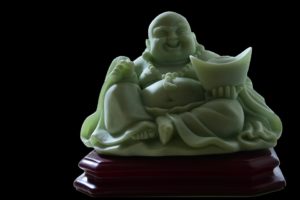 Some time ago I posted a basic guide on concentration meditation.
Some time ago I posted a basic guide on concentration meditation.
There are a lot of different types of meditation, but the two you’re most likely to run into in the West are concentration meditation and insight meditation.
The two types aren’t unrelated. If you do insight meditation properly you will improve your concentration. If you do concentration meditation correctly, you will have insights, mostly to do with how little control you have over what you think of as “your mind.”
If you’re willing to commit enough time, you should do both, and and should also include open awareness meditation at some point.
There are two main goals of these types of meditation. Insight and “yoking.” Yoga, by which I don’t mean the sort of physical exercise which most westerners consider yoga, is first about yoking, second about insight.
Yoking is when all, or almost all parts of your mind (which includes all parts of your body that report in, your “consciousness”) are working together. A yoked mind is clear and stable and capable of doing whatever it wants without distraction.
(I don’t have a yoked mind, but it’s more stable and concentrated than it used to be.)
Yoking is primarily a result of concentration meditation, but it’s aided by having good insights.
Insight meditation is about understanding yourself, and getting your mind/brain/body to accept those insights at a fundamental level. A real insight is more than intellectual, it changes how you experience the world fundamentally. You will feel different after an actual insight (awakening). Often, though not always, this manifests as long held tensions in the body relaxing.
Recently, I had an awakening which released much of the muscles of my lower back, so that it isn’t curved inwards nearly as much. When that persisted over a few days (a.k.a. a few sleeps), I knew it was real.
The more “yoked” your mind is, even before something approaching full yoking, the more likely you are to have insights, because your attention becomes stable. If you are putting your attention on sensations from the body, say, you are more likely to understand those sensations if you can keep your attention on them longer. The same is true if you are examining your thoughts, emotions, internal narrative, or the products of any of your other senses.
The more insight meditation you do, the better your concentration will get, but not as fast as if you were emphasizing concentration.
When I was young, I was a serious runner. In grade 12, I ran about 40 miles a week. I could also do a hundred push ups easily, get up and not be winded, but I was not muscular and could not do many pull-ups or lift heavy weights. The exercise I did made me stronger than doing no exercise, but it wasn’t primarily about strength.
Meditation is, in part, exercise for the mind. Different exercises make the mind better at doing different things, there is overlap, but there is also a trade-off.
Insight meditation heads straight for the goal of much meditation: Rewiring your brain to perceive the world differently. Insights don’t just make you stronger, they make your brain operate differently. Ultimately the goal is to have a brain that operates in ways that a normal brain, without the insights, just can’t, much like an ordinary person can’t waltz without at least some training, or do complicated gymnastics, or walk a tightrope.
Take a third, common form of meditation: loving-kindness. In loving-kindness meditation, you spend your time feeling love. You start with easy to love people, your dog, hopefully your mother, maybe God (if you aren’t scared of God, which most Westerners are), maybe an idol (the Dalai Lama or Gandhi or Nelson Mandela). You move to people you don’t care about, then you move to people you fear or hate.
You do this every day, ideally for hours a day, and you get to the point where you can be feeling love for anyone, all the time, including people who are actively in your face trying to do you harm (nope, I don’t have this; fuck ’em).
This puts you in parasympathetic mode all the time (rest and digest), which is very healthy and good for you. At the top levels, you become one of those people who seem to radiate love all the time. It makes other forms of meditation really easy, because your brain is never scared (you can’t be scared and deeply loving at the same time), and therefore, it shuts up and stops trying to alert you of every possible threat.
The internal martial arts, like Tai-Chi or Bagua, or even Systema, are based on learning some of this: How to punch people with love, how to stay relaxed when a normal person would be freaking out and losing fine motor control (even normal martial artists).
Which is why most people never become good at fighting with internal martial arts: Because they are based on fighting people without much, or ideally any, fear- or anger-based adrenaline response.
So, loving kindness meditation, taken far enough, lets you do something that an untrained mind cannot do. Be loving even to your enemies while they are punching you, or perhaps even if you are punching them. “I don’t punch you because I love you, but I love you while I punch you.”
Many readers will be thinking: “This is bullshit. This is not possible. You are full of it.”
It’s something someone without a lot of training cannot do. Many people cannot even imagine doing it.
So, back to insight meditation. Insight meditation can rewire the brain in a number of ways. The first rewiring I received was “I am not my personality.” Why? Because when my personality changes, as it has through my life, I’m still me. This is easy to understand intellectually, it is hard to believe it in your body and brain.
Insight meditation can also get you to things like “I don’t do anything” which are profoundly alienated from common experience. (See the Bhagavad Gita for the purest expression of this.) I haven’t had this at the full awakening level, but I slip into it at times because I’ve done a lot of meditation around it: I know I don’t “control” my brain or my body or my thoughts. I’ve watched them very closely, I’ve tried to control them, etc.
Other available insights include “Everything passes,” “I am everything,” “I am nothing,” “I am the witness,” “I am not my body,” and some stuff that is even more alienated from common experience like “Suffering is just information I can disregard.”
These awakenings rewire the mind/brain/body. Sometimes only partially, sometimes what seems to be fully, and they are one of the main goals of many serious meditators because you carry these insights with you when you aren’t meditating.
As lovely as yoking is, and as much as the very best meditators can stay there for months, it can be upset. Basic rewiring of the mind/brain from Awakenings, on the other hand, is much more sticky.
And it gives the big rewards, like cessation of suffering, feeling of unity with the world, and so on.
(Some very good meditators are blissed out while meditating and miserable when not meditating. Nice to have, but…)
It should be emphasized that these forms of meditation can work together. The Buddha emphasized three: loving kindness, concentration on the breath, and insight meditation. If you’re loving all the time, it’s easier to concentrate. Easier concentration makes insight easier. Insight gets you the big goals, and hey, yoking is apparently amazing–your body feels good virtually all the time: bliss of body, bliss of mind.
More on all of this at a later date if interest remains high, including basic insight meditation and how to do open-awareness meditation.
(See Also, Some Fruits of Meditation: Simple Happiness.)
The results of the work I do, like this article, are free, but food isn’t, so if you value my work, please DONATE or SUBSCRIBE.

 Our nature is happiness (well, actually bliss) and getting objects or doing things expecting those actions or objects to make you happy won’t work.
Our nature is happiness (well, actually bliss) and getting objects or doing things expecting those actions or objects to make you happy won’t work. It is said that once upon a time, Siddhartha Gautama, before he was the Buddha, was sitting on the ground and was overwhelmed by a great feeling of sweetness towards all that lived, from the bug he saw on the ground, to the grass, and trees, to all the people, and including himself, without any distinction. He remembered that he had felt this way before, as a young child, and he realized in this feeling part of the solution he had sought to the problem of ending suffering.
It is said that once upon a time, Siddhartha Gautama, before he was the Buddha, was sitting on the ground and was overwhelmed by a great feeling of sweetness towards all that lived, from the bug he saw on the ground, to the grass, and trees, to all the people, and including himself, without any distinction. He remembered that he had felt this way before, as a young child, and he realized in this feeling part of the solution he had sought to the problem of ending suffering.
 Some time ago I posted
Some time ago I posted